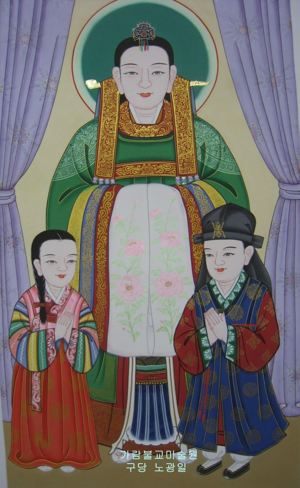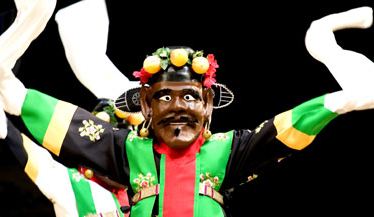Note: This essay in earlier form was originally posted in 2020 to the now-defunct history.expert, during the early days of the COVID-19 pandemic.
On the god of plague and the story of Cheoyong
Content note: Mythological events that may be read as sexual violence or adultery.
Before Koreans knew smallpox as a virus, we knew her as a god. With no way to prevent this terrible infectious disease which had a mortality rate of up to 80% and often left survivors scarred and disabled, we called smallpox by names like “Great Lady” or “Great Guest.”
You could not try to exorcise or even use medicine against the Lady-God; you offered her food and prayed to her in the hope she would spare your loved one, who all too often was a child. Make her angry by disrespecting her, and she could kill the patient or leave them alive but badly scarred, even blinded.
Though the god of smallpox has been personified as different genders and forms from all walks of life, as befitting a disease that could be spread and suffered by anyone, the most familiar shamanic representation is that of a beautiful young woman and that is the version I will go with.

A painting of Hogumama, the smallpox goddess. Source
Now, one figure from the Korean kingdom of Silla in the late ninth century earned the respect and repentance of this terrible and formidable god. This man, Cheoyong(處容), has a strange story of his own:
Heon-gang, the king of Silla at the time, was returning from a seaside excursion when all of a sudden cloud and fog rolled in, causing the entire party to lose their way. The royal sun-administrator, as the weather official who was also in charge of weather-related omens and divination, advised the king that this was the work of the Dragon King of the East Sea, who should be appeased by some good deed.
Though the king was skeptical, no one could see anything because of the strange weather and he had to do something. He ordered a temple be built in that place for the dragon; the instant he said the words, the fog and clouds disappeared.
Pleased at this respectful treatment from the king, the Dragon of the East Sea appeared before the royal retinue with his seven sons to dance and play music, praising the king’s virtue. The dragon then left one of his sons, Cheoyong, with the king to aid him at the capital. The king, happy to have the Dragon’s son by his side, arranged his match to a beautiful woman and gave him a high office to have him settle in the capital.
Cheoyong’s wife was very beautiful, and was admired by all. The god of plague, enamored of her, transformed to come to Cheoyong’s house and secretly lie in his wife’s bed. Cheoyong came home late at night to look upon his bed, only to see two people in it. One was his wife, but he did not recognize the other. At the sight he withdrew, dancing and singing:
東京明期月良
夜入伊遊行如可
入良沙寢矣見昆
脚烏伊四是良羅
二兮隐吾下於叱古
二兮隐誰支下焉古
本矣吾下是如馬於隐
奪叱良乙何如爲理古
Through the city in the light of the moon
I did frolic in the deep of night
I look upon the couch on coming home
And four legs greet my astonished sight.
Two were mine
Whose are the other two?
What once was mine
Was taken, what can I do?
The god of plague showed her true form and knelt before Cheoyong, contrite. Said she, “I envied your wife and have now violated her. Yet you showed no anger at the sight, and this beautiful conduct has moved me deeply. I swear to you, if I but see your form in paint I will not enter that door.”
This was how people started putting up portraits of Cheoyong to deter plague and for good luck. The temple the king built for the dragon was called Mang-hae-sa (望海寺), the Temple of the Ocean View. Cheoyong’s song and dance named for him have been passed on to posterity and the dance is performed to this day, designated as a UNESCO intangible heritage.
The Middle Eastern hypothesis of Cheoyong’s origin
One intriguing hypothesis about Cheoyong’s identity is that he was an Arab or Persian merchant, possibly a doctor. Though there are no explicit records, traders from the Middle East may have been in Silla at this time. At the very least Silla was known in the Middle East, with scholars such as Ibn Khurdaziba in the ninth century writing about Silla as a land beyond China where Muslims happily settled because it was a such a good and plentiful land—as Cheoyong did in the story. In the Persian epic poem Kush-Nama the hero Abtin marries Fararang, a princess of Basila which is alleged to be a mythical version of Silla.
Also, the later Korean dynasty of Goryeo clearly did engage in trade with the Islam world. Not only are there records of large trading parties from the land of Daesik (對食國), meaning Arabia, the name “Korea” itself became known to the West through Middle Eastern merchants. It is an intriguing possibility that exchange between the Korean Peninsula and the Middle East started even before it was formally recorded in the Goryeo era, with the tale of Cheoyong passed down as a mythologized hint much like Ibn Khurdaziba’s writings on Silla or the adventures of the Kush-Nama.
The accounts of Cheoyong’s appearance before the king are suggestive as well. The fact that he and his family rose out of the sea could be a mythologized rendition of their seafaring, while their strange appearance and clothing astonished the Korean onlookers and caused them to call the strangers “spirits of the sea.” More specifically, Cheoyong was said to have deep-set eyes and a prominent nose, features that have been preserved in an exaggerated form in his portraiture and the mask performers wear for his dance.
 A performance of Cheoyong’s dance in his mask. Source
A performance of Cheoyong’s dance in his mask. Source
The Islamic world also had some of the most advanced medical knowledge in the world at this time, building on the preserved knowledge from the classical world and adding to it with innovation and observation. The year 879 when Cheoyong was said to have come from the sea was early in the career of Muhammad ibn Zakariya al-Razi (854-925), a Persian doctor and polymath who wrote a pioneering book on smallpox and measles.
If Cheoyong were a Middle Eastern man with medical knowledge he may well have had access to the kind of research and methods Al-Razi used, if not the specific book, which may have enabled him to treat people afflicted with smallpox. These events may then have been mythologized as Koreans at the time understood it, a ceremonial appeasement of the smallpox god, making him an enduring legend and himself a beloved god in our pantheon.
In conclusion: Solidarity in times of plague
Cheoyong’s exact identity and background, including whether he was a real person, will always remain mysterious and up for debate. Nevertheless, the possibility that he was an Arab or Persian is particularly poignant at a time when COVID-19 is bringing out virulent xenophobia and racism around the world. Cheoyong may well have been a foreigner risking his life in a strange land to help patients struck with a deadly and highly contagious disease.
And now, 1,100 years later, Iran is hard hit by the disease and by the sanctions that are undercutting its response. It is requesting Korea’s aid to secure more testing kits for citizens, an effort made difficult by the sanctions imposed against it. This may very well be the time Korea can repay the debt it owes Cheoyong. Wouldn’t such beautiful conduct move even the fearsome god of plague?
References
The original tale: Ilyeon (1281, King Chungryeol Year 7). Sir Cheoyong and the Temple of the Ocean View (處容郞望海寺), Book 2 of Stories from the Three Kingdoms (三國遺事).
Cheoyong’s tale as an appeasement of the smallpox god: Hwang Byeong-ik (2011). The Study about Original Form of Small Pox Goddess & the Meaning of Silla 〈Cheoyong-ga〉. Journal of Korean Studies (formerly Journal of Spiritual Culture Studies), 34(2), 127-152.
Silla-Middle East relations: Muhammad Kansu/Jeong Su-il (1990). The History of Relations Between Silla and Arab Muslim Countries. Ph.D. thesis for the History Department of Dankook University.